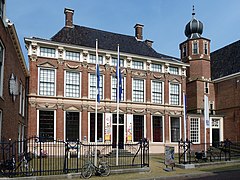art.wikisort.org - Museum
The Princessehof Ceramics Museum (in Dutch: Keramiekmuseum Princessehof) is a museum of ceramics in the city of Leeuwarden in the Netherlands. The museum's name comes from one of two buildings in which it is housed: a small palace (hof means ‘royal court’) built in 1693 and later occupied by Marie Louise, dowager Princess of Orange. The other annexed building is the Papinga stins, a former stronghold from the 15th century. The museum buildings are of interest, and so are its collection of tiles, pottery, and ceramic sculpture.[1]
Keramiekmuseum Princessehof | |
 Princessehof Ceramics Museum | |
 | |
| Established | 1917 |
|---|---|
| Location | Grote Kerkstraat 9 Leeuwarden, Netherlands |
| Coordinates | 53°12′10.76″N 5°47′31.72″E |
| Type | Art museum |
| Collections | Ceramic art |
| President | Saskia Bak |
| Curator | Frank van der Velden, Eva Ströber, Karin Gaillard |
| Website | www |
History of the building
In 1731, the building was purchased by Marie Louise (known in Leeuwarden as Marijke Meu, 'Aunt Mary'), who had been a widow since 1711 and acted as regent for her son William IV up to that year, when he came of age. She moved in and began a collection of ceramics, and her collection forms part of the museum's collection, most notably in the Nassaukamer, a period dining room in Baroque style. After she died, the building was split into three houses, and one of these later came into the hands of the Leeuwarden notary and art collectors Nanne Ottema (1874–1955) and his wife Grietje Kingma, who founded the museum during their lifetime in 1917.
The Dutch graphic artist M.C. Escher, known for his often mathematically inspired woodcuts, lithographs, and mezzotints, was born in the middle house in 1898.[2]
Ceramics
The Ottema-Kingma Stichting (foundation) keeps the tradition of the founders alive with an online database for the collection and associated library.[3] This Stichting is also the formal owner of the Asian ceramics collection, with items ranging from 2800 BC up to the 20th century.[4] Besides the Asian collection, there is also a wide range of European and some Islamic ceramics.
Facilities
The museum has a café and often hosts visiting art exhibitions. The museum also permanently exhibits the former studio of the Dutch ceramist Jan van der Vaart.[5]
Gallery
Selection of work from the pertinent collection:[6]
- Tile flower painting
- Yellow vase
- Wall of Chinese Zhangzhou ware plates
- Delftware
- Mantelpiece
- Porcelain painting on a mantelpiece
References
- George McDonald (2011). Frommer's Belgium, Holland and Luxembourg. p. 398.
- Maurits Cornelis Escher, Flip Bool, J. L. Locher (1982). M.C. Escher, his life and complete graphic work. p. 10
- Nina Simon (2010). The Participatory Museum. p. 107
- Asian ceramics, Rijksmuseum.
- Museum Princessehof | Studio Jan van der Vaart Interactive spatial concept Archived 2016-03-04 at the Wayback Machine at mattmo.com. Accessed 15.06.2015.
- For more images, see Category:Collection of Keramiekmuseum Princessehof
External links
- Museum website (in English)
- Ottema-Kingsma Stichting website (in Dutch)
На других языках
[de] Princessehof
Der Princessehof ist ein Museum für Keramik und Porzellan in der niederländischen Stadt Leeuwarden. Das Museum befindet sich in einem barocken Stadtpalast aus dem 17. Jahrhundert, der vormals als Wohnsitz der Prinzessin Marie Luise von Hessen-Kassel diente. 1917 gründete der Notar und Kunstsammler Nanne Ottema in diesem Gebäude das Museum Princessehof. Die gemeinsam mit seiner Frau Grietje Kingma zusammengetragene Sammlung asiatischer Keramiken und Porzellane ist als Leihgabe der Ottema-Kingma-Stiftung Teil der Dauerausstellung des Museums. Ein weiterer Schwerpunkt des Museums sind Arbeiten des niederländischen Jugendstil und Art Déco sowie zeitgenössische Objekte, die in der Abteilung europäischer Porzellane und Keramiken zu sehen sind.- [en] Princessehof Ceramics Museum
[ru] Принсессехоф
Принсессехоф (нидерл. Keramiekmuseum Princessehof) — музей керамики в городе Леуварден в Нидерландах. Название музея происходит от одного из двух зданий, в которых он расположен: небольшого дворца (hof означает «королевский двор»), построенного в 1693 году и позже занятого Марией Луизой. Другим пристроенным зданием является бывшая крепость 15 века. Здания музея представляют интерес, как и его коллекция изразцов, керамики и керамических скульптур[6]. В музее есть кафе и часто проводятся выездные художественные выставки. В музее также экспонируется бывшая мастерская голландского керамиста Яна ван дер Ваарта[en].Другой контент может иметь иную лицензию. Перед использованием материалов сайта WikiSort.org внимательно изучите правила лицензирования конкретных элементов наполнения сайта.
WikiSort.org - проект по пересортировке и дополнению контента Википедии





